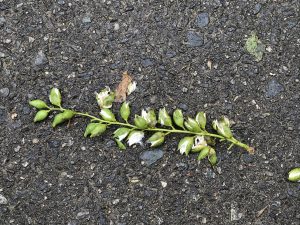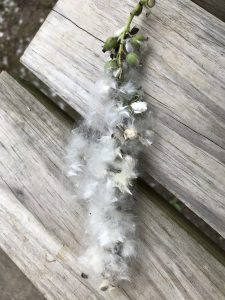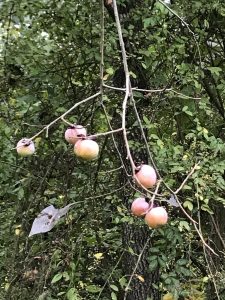As summer wanes and fall begins, seeds are ripening and falling from many trees and wildflowers along my path. Some trees set their seeds early in the spring such as the cottonwood that makes my pathway look like a sudden snowstorm blew in overnight. Those of you who have been with me for a while know that I love every stage of this seed from its green and white beginnings to its fluffy airborne seeds that make spiderwebs visible and my walk delight. If I were a bird, I’d build my nest and line it with these seeds.
Another tree that sets abundant seed is the tulip. I am continually pulling out its seedlings from my garden. I’ve yet to see the seeds on the ground, but their offspring have a magical way of suddenly poking through my flowers. I hate pulling them out, but I’ve learned that if you let them grow, they get more tenacious about their life. It soon takes extraordinary strength or a shovel to get them out of the ground. Right now the maple seeds that have been hanging in clusters on the trees all summer are starting to turn light brown and spin down. Acorns are beginning to litter the pathway, at least those the squirrels haven’t carried off.
The persimmons squashed on the pathway from walkers and bikers have left behind large brown seeds, not unlike the watermelon seeds we used to spit at each other. If you had asked me what a persimmon seed looks like before this fall, I would have guessed that it had a pit like a nectarine. I never encountered persimmons until I moved here.
During the sixth day of creation, God spoke plants into being. I find it fascinating that He created plants that set their own seed such as the trees and wildflowers as well as fruit bearing plants that contain seeds such as the persimmons. Every seed looks different and uses a different method of distribution. It is also striking how many seeds are produced versus how many seedlings actually take root. Most of the trees along my path have put out thousands if not millions of seeds. God knows the actual number as well as the mathematical probability of how many will sprout, and of those, which will evade the marauding deer and squirrels and grow into tall trees. In short, He knows how many seeds must be produced to sustain that plant’s life. And if that wasn’t enough, we know from scientific studies that He built into the tree’s DNA the ability to “know” when it must create more seed in any one season.
The wildflowers that grace my pathway in September are bright yellow and purple. Now that it’s October, only a few remnants can be found as they too are busily going about setting seed. Some of the purple wildflowers are striking like the ironweed and blazing star. The yellow is shared by the goldenrod and some of the false sunflowers and asters. Purple and yellow are opposite colors on the color wheel that God chose for our fall display. As the days wane, some of the asters that bloom are now a soft violet and white as if fading with the season.
How grateful I am that the Lord designed every plant, tree and flower to set seed for the following year. As much as I hate to see the dark brown, black and tawny seed pods appear because they signal the end of the season, I know they are the forerunners of next year’s blooms. Hidden in the frozen ground for months, they await the spring sunshine, rain and timing before sprouting.
Perhaps it goes without saying, but seeds carry the essence of life. Encoded in these minute pieces of creation are God’s instructions of how to grow and what type of tree or wildflower to become. One of the most renown nature writers of the 20th century was Hal Borland. I came across a quote of his in a wonderful book written about the Smokies.
“Man is wise and constantly in quest of more wisdom; but the ultimate wisdom, which deals with beginnings, remains locked in a seed. There it lies, the simplest fact of the universe and at the same time the one which calls forth faith rather than reason.”*
If you look in the Bible for the word seed, you will find several parables and different uses for the word. The parable of the sower is one of the most known, the seed being the Word of God. As is the story of the mustard seed that teaches about faith. The smallest of seeds, it grows into a tree in which the birds nest. When you are with your kids or grandkids talk about seeds and see what they observe and what they know about what the Bible says.
The next time you are out walking in your garden or on a hike, or even in your neighborhood, take note of the different kinds of seeds that you see. I expect you will be pleasantly surprised. And notice where the wildflowers are that you love, so next year you can revisit those places and see them again.
“And those who are peacemakers will plant seeds of peace and reap a harvest of righteousness.”
James 3:18 NLT
*Hal Borland, Sundial of the Seasons (J B Lippincott Company 1964)
From: Lift your Eyes to the Hills by Margaret O Greene; Branning Publishing 2018






